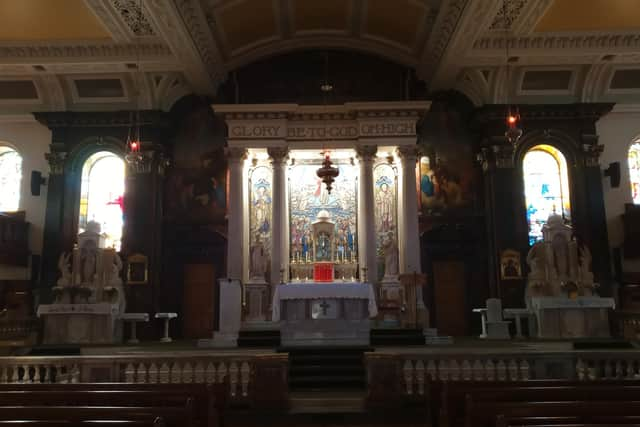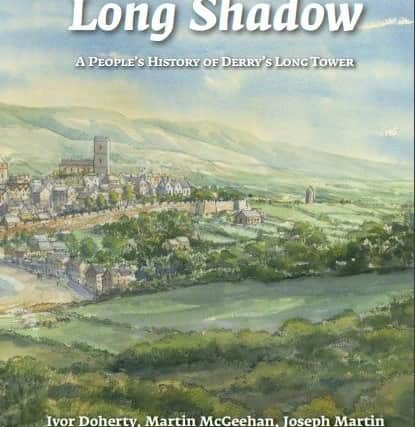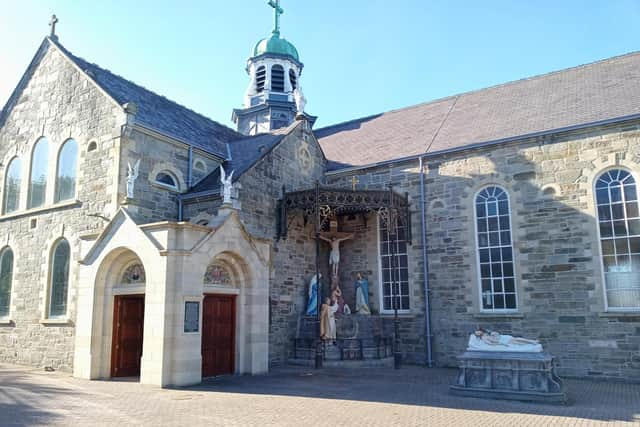The Long Tower, Derry: The Priest and the Painter
and live on Freeview channel 276
In the early 1900s a London based painter spent two years creating the biblical scenes which adorn the walls of the Long Tower Church.
It was an unusual and courageous decision by Fr. Willie Doherty of St Columba’s Church in Derry to commission a London-based portrait artist, Ambrose McEvoy,
Advertisement
Hide AdAdvertisement
Hide Adto produce a comprehensive series of paintings of biblical scenes for the Long Tower Church, in 1906.


Maybe the name McEvoy suggested Irish descent but McEvoy, following training at the Slade School of Fine Art, from 1893, was completely immersed in the London art scene.
He was friends with the key artists of the day in London, such as James McNeill Whistler and Augustus John and was making his name as a society portrait painter after beginning his professional career with an exhibition in the New English Art Club in 1901. In that early period he became known for using stage lighting to create striking, almost cinematic, portraits and interior scenes in oils but sometimes also in watercolours.
The commission from Fr. Willie Doherty was McEvoy’s first major site-specific project involving original works and twenty two copies of paintings of biblical scenes based on artworks by Renaissance Masters. McEvoy was inspired by the techniques of artists such as Titian and Rembrandt and other painters of the Italian Renaissance in the 16th century. Early on he and Augustus John travelled together in Europe to study the works of these master painters.
Advertisement
Hide AdAdvertisement
Hide AdThe paintings for St Columba’s Church took over two years to complete, with the original commission for 18 copy paintings increased to 22. McEvoy was assisted by his wife, Mary, herself an accomplished painter...


In thinking about the initiative shown by Fr. Doherty, in sustaining the eminence of St Columba’s in the Diocese through a refurbishment programme, it is also interesting to see how forthright he was, in letters to the artist, in proposing preferred Old Master paintings for McEvoy to use. He even critiqued a painting by Raphael, saying… “The angel is in quick motion and the drapery is a bit clumsy. Before you decide on this have a look at Albertinelli’s Madonna.....I think the kneeling angel is preferable.”
Fr. Doherty then refers to a page number in a book of art reproductions that he was obviously using as a source of images. But it is also clear that he understood that an art commission is actually a negotiation, between client and artist, and between material and immaterial considerations. In one letter he says.… “I have tried to make my ideas of catechism fit in with your ideas of art.”
Neither was he slow in offering a mild rebuke to the artist in discussing a painting of the finding of Jesus in the Temple.… “I told you before that I would like this subject to be the finding and not the dispute....”
Advertisement
Hide AdAdvertisement
Hide AdThe best art commissions always involve a debate about subjects, techniques, context and budgets so it is no surprise to see the detailed discussions which took place between the client, St Columba’s Church/Fr. Doherty and the artist. Fr. Doherty also had something to say about the cost of copper, the unusual support used by McEvoy for these paintings: “I presume, as indicated, copper is more easily purchasable now.......”


In terms of this technique, the paintings in St Columba’s were unusual for the time, in that they are painted on copper. Though common in the 16th and 17th centuries, especially in Italy, as a process painting on copper fell out of favour in the 18th and 19th centuries. Copper provided a smooth surface for detailed painting and gave the paint finish a luminosity. In some cases, artists would employ the sheen of the copper as an element in a finished painting. In the context of this commission it can be assumed that the durability of paintings on copper over paintings on canvas or wood was a deciding factor. This is especially true of paintings which were/are intended to last as long as the church itself lasts, so integrated into the architecture of St Columba’s are McEvoys artworks.
Paintings on copper, historically, tended to be relatively small in scale, for reasons to do with the cost of copper, but McEvoy’s copy of Leonardo Da Vinci’s ‘Last Supper’, which sits over the central altar, with McEvoy’s ‘Adoration of Kings’ and ‘Adoration of the Shepherds’ on either side, is an unusually large scale painting on copper. In fact the sheet of copper for this painting was so large that a picture slit had to be cut into the artist’s studio to get the copper sheet in and to get the finished
painting out. The ‘Last Supper’ painting, along with the twenty two copied works were completed and installed in 1909.
Advertisement
Hide AdAdvertisement
Hide AdThis is just one part of the narrative around a remarkable commission for the unique context of St Columba’s Church, Long Tower, which involved, not only the skills of the artist, Ambrose McEvoy, but also the foresight of a local priest, Fr. Willie Doherty, who was able to ‘think long’ and to invest in the future of St Columba’s Church on behalf of the Long Tower parish and the City of Derry.
*Declan McGonagle is the Former Curator of the Orchard Gallery, Derry, Director of the Irish Museum of Modern Art and Director of the National College of Art and Design, Dublin.